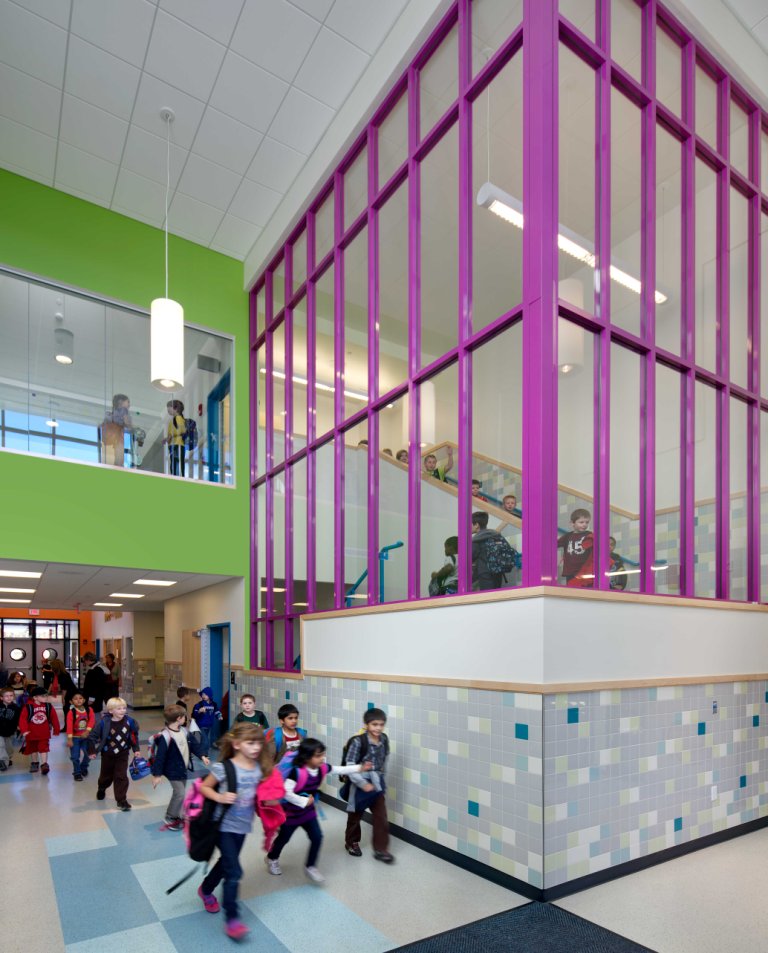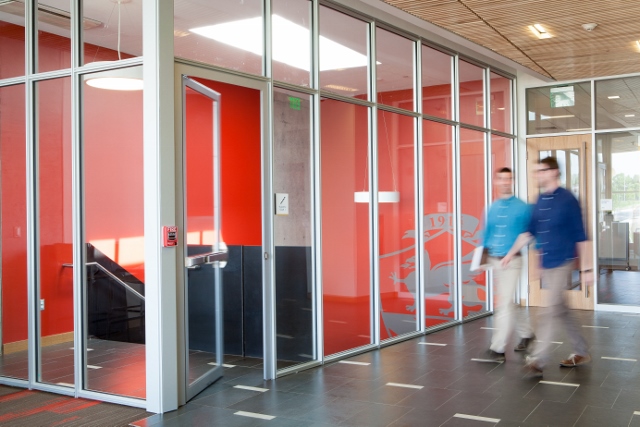As more students enter the school system each year, designing for fire safety in educational facilities has never been more critical. Fire-rated glazing can be a key part of the solution. With proper specification, it can defend against the spread of fire, resist impact from rambunctious students and transfer natural light into learning areas, which can improve student performance.1
A case in point is the design and development of an egress stairwell in Concord, New Hampshire's Mill Brook Elementary School. To support the school’s vision for developing a multi-use “learning corridor” that brings education beyond the classroom, HMFH Architects designed the fire-rated stairwell to be bright and open, reflecting the playful energy of students. They achieved this goal by pairing Fireframes® Aluminum Series fire-resistant frames with Pilkington Pyrostop® fire-resistant glass, both supplied by Technical Glass Products (TGP).
Rather than the bulky, wrap-around frames often associated with traditional fire-rated framing systems, the Fireframes Aluminum Series fire-rated frames have slender profiles that can be custom wet painted, anodized or powder coated in nearly any color. In this application, the narrow fire-rated frames were powder coated a bright purple to match the interior color scheme—a key aesthetic benefit since learning areas are integrated into public spaces outside student classrooms.
Pilkington Pyrostop fire-resistant glazing allowed the design team to incorporate unrestricted amounts of transparent glazing in the stairwell to improve light transfer. The product also offers fire-ratings of up to two hours, and blocks the transfer of radiant heat, providing essential protection should students need to exit the building during a fire. Pilkington Pyrostop meets the impact requirements of CPSC 16CFR1201 Category I and/or Category II – a critical performance benefit for glass used in busy stairwells.
TGP’s Fireframes Aluminum Series fire-rated frames with Pilkington Pyrostop transparent fire-rated glazing also proved beneficial during the renovation of Johnson & Wales University Center for Physician Assistant Studies. The building’s lack of openness and accessibility to the street was a concern for DBVW Architects during the design phase. “The original main entrance to the building was not handicap accessible and not as grand as we envisioned for Johnson & Wales’ new Physician Assistant Program,” explains Sean Redfern, associate principle for DBVW Architects.

Bright purple fire-rated egress stairwell at Mill Brook Elementary School
For the lobby and stairs to satisfy building codes and successfully work together to create a clear circulation path for students and faculty entering the school, DBVW Architects paired the Fireframes Aluminum Series fire-rated frames with Pilkington Pyrostop transparent fire-rated glazing.
“Together, the thin profile design of TGP’s Fireframes Aluminum Series fire-rated frames and clear Pilkington Pyrostop fire-rated glass helped us achieve the transparency and fire protection we were looking for in the space,” explains Sean Redfern, associate principle for DBVW Architects. “Using fire rated glass for an entire exit stair enclosure isn’t something you see every day. But the openness that TGP’s fire-rated frames and glass created fit well with our design aspirations.”
For more information on how to select first-class glass solutions that can support fire and life safety protection and student wellbeing goals in schools, please visit fireglass.com.
1Sapna Cheryan, Sianna A. Ziegler, Victoria C. Plaut, and Andrew N. Meltzoff. Designing Classrooms to Maximize Student Achievement. Policy Insights from the Behavioral and Brain Sciences, 2014
Windows and Classrooms: A Study of Student Performance and the Indoor Environment, a 2003 study conducted by the Heschong Mahone Group.
Technical Glass Products
800.426.0279
800.451.9857 – fax
sales@fireglass.com
www.fireglass.com
Related Stories
| Aug 11, 2010
Bronze Award: Garfield High School, Seattle, Wash.
Renovations to Seattle's historic Garfield High School focused mainly on restoring the 85-year-old building's faded beauty and creating a more usable and modern interior. The 243,000-sf school (whose alumni include the impresario Quincy Jones) was so functionally inadequate that officials briefly considered razing it.
| Aug 11, 2010
Managing the K-12 Portfolio
In 1995, the city of New Haven, Conn., launched a program to build five new schools and renovate and upgrade seven others. At the time, city officials could not have envisioned their program morphing into a 17-year, 44-school, $1.5 billion project to completely overhaul its entire portfolio of K-12 facilities for nearly 23,000 students.
| Aug 11, 2010
Financial Wizardry Builds a Community
At 69 square miles, Vineland is New Jersey's largest city, at least in geographic area, and it has a rich history. It was established in 1861 as a planned community (well before there were such things) by the utopian Charles Landis. It was in Vineland that Dr. Thomas Welch found a way to preserve grape juice without fermenting it, creating a wine substitute for church use (the town was dry).
| Aug 11, 2010
School Project Offers Lessons in Construction Realities
Imagine this scenario: You're planning a $32.9 million project involving 112,000 sf of new construction and renovation work, and your job site is an active 32-acre junior-K-to-12 school campus bordered by well-heeled neighbors who are extremely concerned about construction noise and traffic. Add to that the fact that within 30 days of groundbreaking, the general contractor gets canned.
| Aug 11, 2010
High Tech High International used to be a military facility
High Tech High International, reconstructed inside a 1952 Navy metal foundry training facility, incorporates the very latest in teaching technology with a centerpiece classroom known as the UN Theater, which is modeled after the UN chambers in New York. The interior space, which looks more like a hip advertising studio than a public high school, provides informal, flexible seating areas, abunda...
| Aug 11, 2010
High-Performance Modular Classrooms Hit the Market
Over a five-day stretch last December, students at the Carroll School in Lincoln, Mass., witnessed the installation of a modular classroom building like no other. The new 950-sf structure, which will serve as the school's tutoring offices for the next few years, is loaded with sustainable features like sun-tunnel skylights, doubled-insulated low-e glazing, a cool roof, light shelves, bamboo tri...
| Aug 11, 2010
Special Recognition: Pioneering Efforts Continue Trade School Legacy
Worcester, Mass., is the birthplace of vocational education, beginning with the pioneering efforts of Milton P. Higgins, who opened the Worcester Trade School in 1908. The school's original facility served this central Massachusetts community for nearly 100 years until its state-of-the-art replacement opened in 2006 as the 1,500-student Worchester Technical High School.
| Aug 11, 2010
BIM school, green school: California's newest high-performance school
Nestled deep in the Napa Valley, the city of American Canyon is one of a number of new communities in Northern California that have experienced tremendous growth in the last five years. Located 42 miles northeast of San Francisco, American Canyon had a population of just over 9,000 in 2000; by 2008, that figure stood at 15,276, with 28% of the population under age 18.
| Aug 11, 2010
8 Tips for Converting Remnant Buildings Into Schools
Faced with overcrowded schools and ever-shrinking capital budgets, more and more school districts are turning to the existing building stock for their next school expansion project. Retail malls, big-box stores, warehouses, and even dingy old garages are being transformed into high-performance learning spaces, and at a fraction of the cost and time required to build classrooms from the ground up.
| Aug 11, 2010
Special Recognition: Kingswood School Bloomfield Hills, Mich.
Kingswood School is perhaps the best example of Eliel Saarinen's work in North America. Designed in 1930 by the Finnish-born architect, the building was inspired by Frank Lloyd Wright's Prairie Style, with wide overhanging hipped roofs, long horizontal bands of windows, decorative leaded glass doors, and asymmetrical massing of elements.







